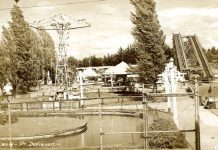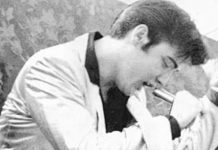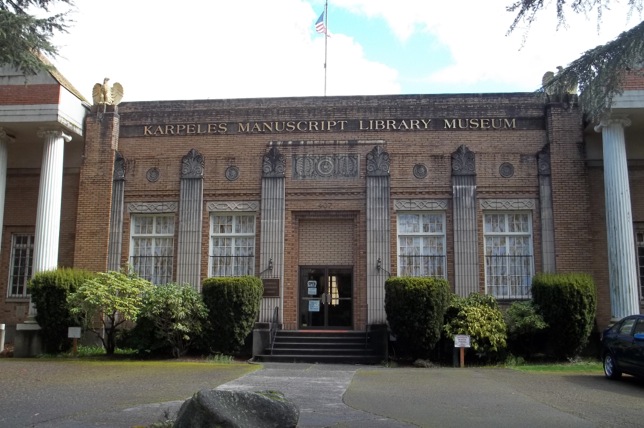By Jean Janes
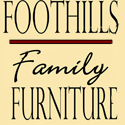 In the contemplative silence at the Karpeles Manuscript Museum, one can nearly hear the whispers of the past emanating from the papers under the glass. Private letters expressing love, worksheets cataloguing ancient details of daily life, magical moments in music and scientific discovery – frozen in time in pencil or ink.
In the contemplative silence at the Karpeles Manuscript Museum, one can nearly hear the whispers of the past emanating from the papers under the glass. Private letters expressing love, worksheets cataloguing ancient details of daily life, magical moments in music and scientific discovery – frozen in time in pencil or ink.
Looking at old documents may not seem remarkable, but there is something exceedingly intimate about a person’s handwriting. It is one thing to read the amazing things people like Evita Peron or Mahatma Gandhi wrote in print, but to see those words written in their own hand is like hearing their voices across the years. I had the privilege to not only visit the museum recently, but also to sit down with Thomas Jutilla, director of the Karpeles Tacoma location.
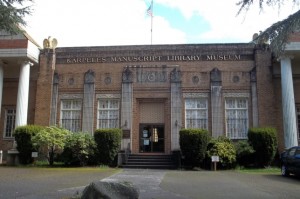
“It’s like a time capsule,” Jutilla says of the museum where he has devoted the last 20 years. The Karpeles Museum is not simply presenting the typical artifacts or material relics, but instead is providing chronicles of people’s lives and works in and by their own hand. Jutilla elaborates, “When you actually read the first person, it can move you.”
I am inclined to agree with him. As I tour the main hall, I visually trace the graceful penmanship of Evita Peron’s letters to her husband written while on her deathbed. Speaking to her humanity in another fashion, among the pieces in this exhibit is also copy of her dental records. Displayed in another area, a letter written by Elizabeth I. The subject matter deals with instructions to Sir Frances Drake and the defense of England against the Spanish Armada, but I am most captivated by her elaborate signature. Her royal autograph is both striking and elegant. Nearby, a page from Puccini’s operatic gem, Madame Butterfly, shows his dynamic and sweeping notes, musical inspiration captured in ink.
Sitting down with Jutilla, he shows me quality reproductions of documents currently being stored elsewhere or on display at one of the other eleven Karpeles Museums across the country. Meticulously outlining the timetable for his Narnia masterpieces, C.S. Lewis wrote in small and even letters. A sample of Helen Keller’s handwriting is careful and straight. Jutilla explains that “More than just the writing, you discover who the person really is,” and I understand what he means. A childhood hero of mine, I voraciously read everything I could find about Helen Keller and her lifelong friend and teacher, Anne Sullivan. As I study her penmanship now, the actual subject matter of her letter is of little interest to me. I am far more fascinated in the personality her script conveys. Of course, I am sure that what I know about her accomplishments color my interpretation, but I still see a neat, intelligent and gifted individual emerge from the lines of her lettering.
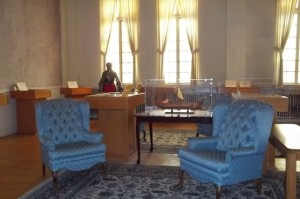
As I tour the museum, Jutilla explains the location. The building itself is of historical value. Built in 1931, the building originally served as an American Legion Post in honor of Lieutenant Edward B. Rhodes who was killed in World War I. In 1991, the building became the Karpeles Manuscript Library Museum and it remains open and free to the public to this day. The exhibits rotate with the other Karpeles Museums in order to provide visitors a new experience with each tour. For example, the Museum is currently showing pieces focusing on the beginning of baseball.
In the foyer near the entrance, I am confronted with a page of the navigator’s log of the Enola Gay, the plane and crew responsible for dropping the atomic bomb on Hiroshima, that fateful day on August 6, 1945. This simple piece of paper describes the weather, altitude, speed and time down to the second as the crew carried out their terrible task. So personal, so human, I can imagine this individual carefully annotating his log, performing his mundane duties while also completing one of the most historically momentous of missions.
I have never experienced history in such an unmediated way. There is no extraneous third-party interpretation between the actual writings of these significant individuals and me.
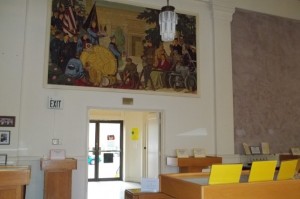
Welcoming field trips, offering tours, and providing admission free of charge for all, the Karpeles Manuscript Museum is helping to make sure that our communities will benefit from this private collection as much as possible, and for years to come.
Jutilla says of the experience of this place, “You’re actually hearing them talk to you,” and as I complete my walk through the Karpeles Manuscript Museum, I hear the past in a clear and human way I did not realize was possible. It is a haunting feeling, but only because these historical figures that have always felt so distant suddenly are feeling very present and near.
You can visit the Karpeles Manuscript Museum, located at 407 South G Street in Tacoma, Tuesday-Friday, 10:00 a.m.-4:00 p.m. For more information about the museum, visit Karpeles’ website here.
























